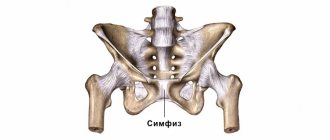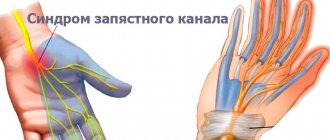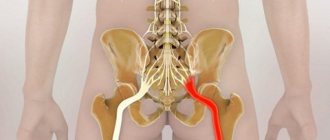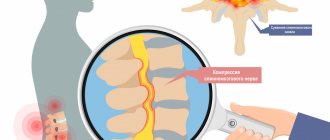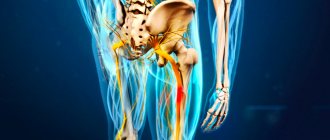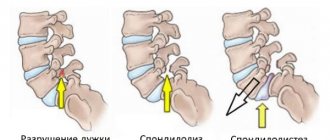The sciatic nerve runs from the lumbar spine, buttocks and back of the thighs to the feet. It supports the back of the thigh muscles, as well as the entire lower leg and foot. The sciatic nerve is a collection of nerve roots that emerge from the spine. When a nerve is pinched, a pathological condition called sciatica occurs - a person feels discomfort, pulling or acute pain.
Any rapid movement—standing up, bending, or lifting heavy objects—can trigger back pain. Sciatica can be characterized by sharp, sharp, or even burning back pain that radiates to the lower back, hip, or foot, depending on which part of the sciatic nerve is pinched. In some cases, sciatica leads to limited mobility as painful symptoms increase with the slightest activity. The patient may experience sensory disturbances in the lower extremities, as well as muscle weakness and numbness.
Sciatica is aggravated by coughing, sneezing and laughing: after all, these actions increase the pressure of the cerebrospinal fluid, which causes additional pressure on the roots of the sciatic nerve. You can recognize the disease yourself by conducting a false test - you need to lie on a hard surface and try to raise your straight leg. Sudden pain is a reason to contact osteopaths.
A patient suffering from symptoms typical of sciatica may have problems with bowel movements and even suffer from muscle paresis. These are signs of significant damage within the discs and in this form the disease may require neurosurgical treatment.
Sciatica - causes
Sciatica is a set of symptoms that develops as a result of compression of the sciatic nerve at the level of the L5, L4 or S1 discs. The main causes of sciatica are discopathy and degenerative changes in the intervertebral discs.
Between the vertebrae there are fibrocartilaginous discs with a gelatin core - they provide shock absorption, elasticity and impact resistance. Over the years, the shock-absorbing properties of the discs weaken, and the spine is more difficult to bear the load. However, not only age affects the condition of intervertebral discs. Lifestyle, certain diseases and other factors are also important.
- Pressure on the sciatic nerve can also be caused by overweight/obesity, diabetes, local inflammation or cancer.
- Other possible causes of sciatica include narrowing of the spinal canal, spondylolisthesis, and excessive tension in the piriformis muscle.
- The sciatic nerve can be damaged by a diet low in calcium, mineral salts and vitamins.
- It happens that sciatica occurs in people who have been exposed to hypothermia - for example, lying on wet ground or swimming in cold water on a hot day.
Risk factors for sciatic nerve pain
Risk factors for developing a pinched sciatic nerve include:
- Age. Age-related changes in the spine, such as a herniated disc, are the most common causes of sciatica.
- Occupation. Jobs that require frequently turning your back, carrying heavy loads, or driving a vehicle.
- Passive lifestyle. People who sit for long periods of time and are physically inactive are more susceptible to this pathology than active people.
- Diabetes. This condition, which determines how your body uses blood sugar, increases the risk of nerve damage.
Causes of pinched sciatic nerve in pregnant women
During pregnancy, the spinal column of the expectant mother experiences a significant increase in load. The sacrum also suffers greatly, which becomes most noticeable in the last third of pregnancy. This is due to the fact that the greatly enlarged uterus begins to put pressure on nearby tissues and organs. It is here that the sciatic nerve is located, which in the process of such pressure begins to become inflamed.
The main causes of sciatica include:
- sudden weight gain;
- multiple pregnancy;
- a large amount of amniotic fluid;
- lack of normal physical activity on the body of the expectant mother;
- hypothermia of the lower body, mainly the pelvic area;
- strong physical activity, lifting heavy weights.
In addition, the occurrence of sciatica during pregnancy is often facilitated by ailments and conditions that were diagnosed before the woman decided to become a mother. In this situation, any disease can worsen in a woman. Sciatica can be caused by:
- Injury to the spinal column.
- Osteochondrosis.
- Protrusions and hernias.
- Diabetes mellitus, as well as other metabolic diseases.
- Infections in the pelvis.
If a woman has not previously had any problems with the sciatic nerve, and there are no diseases that provoke it, she can only encounter the disease shortly before giving birth. At the same time, age is not important - both young and older mothers can notice symptoms of pinching. As a rule, in this case, after the birth of the child, the discomfort from pinching goes away.
Sciatica during pregnancy
One of the body conditions that can contribute to the appearance of sciatica is pregnancy, in particular its second trimester. During pregnancy, a woman gains weight, the baby grows, and the spinal ligaments weaken. Excessive stress on the spine or poor alignment can lead to disc prolapse. Pregnancy often increases pressure on the sciatic nerve.
It is important to understand that back pain during pregnancy is a fairly common symptom and does not necessarily mean you have sciatica. It can be caused by expansion of the pelvic bones, so high-quality diagnosis and consultation of several specialists is necessary - from a gynecologist to a neurologist and osteopath.
Next steps for a pinched nerve in your leg or lower back
An expectant mother may experience pain and discomfort when her sciatic nerve hurts during pregnancy, which is also upsetting and causes additional stress. Exercises for pinched sciatic nerves during pregnancy can relieve pain by reducing muscle tension and increasing mobility in the hips, lower back, and legs. The pain may worsen if you sit or stand for long periods of time. So be sure to change your positions throughout the day.
Listen to your body and stop activities that cause hip pain. Always talk to your doctor before starting an exercise routine. If you have any symptoms, such as dizziness, headaches, or bleeding, stop exercising for back pain and get medical help.
Diagnostics
Diagnosis of sciatic nerve abnormalities is based primarily on medical history. Based on the patient's symptoms and clinical examination, the doctor can determine the cause of the pain and suggest treatment and rehabilitation. However, diagnostic tests are often required to provide further information. People struggling with sciatic nerve pain are referred to:
- For magnetic resonance imaging
- X-ray
- Computed tomography.
Treatment
Sciatic nerve pain should not be underestimated! Although home remedies can relieve some symptoms, it is important to understand that prolonged compression can permanently damage the structure of the sciatic nerve. To relieve pain in the sciatic nerve, you can take painkillers, but only until you can see a specialist. Then, after the diagnosis, he will make an accurate diagnosis, determine the presence or absence of sciatica, its severity.
Suitable treatment methods are selected taking into account the history of the disease, its causes, as well as individual contraindications. It is important to determine the degree of damage or injury to nerve endings and to study pathological processes in the discs so as not to aggravate them.
Standard treatment is painkillers and anti-inflammatory drugs and rest. Unfortunately, this approach to treating a pinched sciatic nerve only temporarily corrects the situation. At first, the pathology occurs rarely, but over time, sciatica appears more and more often; pain can torment a person several times a year. Obviously, the best solution to this situation is to find and eliminate the source of the problem. A qualified osteopath can help with this.
Sciatica and pregnancy
According to Healthline, 50 to 80% of women experience lower back pain during pregnancy.
Low back pain is most often caused by sciatica. Symptoms of the disease include muscle spasms, difficulty walking, and sharp, shooting pain that radiates from the buttock down the back of the thigh.
Many pregnant women experience similar low back pain, with the number of episodes of significant pain increasing as pregnancy progresses and more common in the third trimester.
In this article, Dr. Meredith Langhorst explains why sciatica pain occurs during pregnancy, how to avoid it, and treatment options.
What is sciatic neuralgia pain during pregnancy?
According to Dr. Langhorst, “sciatica during pregnancy occurs due to an increase in the amount of the hormone relaxin in the mother’s body, which causes the ligaments to weaken in preparation for childbirth.”
Although ligament changes are normal, they contribute to a shift in the center of gravity, which in turn can lead to inflammation or pinching of the sciatic nerve.
How does sciatica pain occur?
Sciatic nerve pain occurs in the spine. The spine consists of 24 vertebrae, which are located on top of each other. The vertebrae serve as a shield protecting the spinal cord. Seven small vertebrae that begin at the base of the skull form the cervical spine. The thoracic and lumbosacral sections of the spine are formed in the same way.
The spinal cord and nerves run through the spinal canal, carrying signals from the brain to the muscles and back again. The structure of the intervertebral discs is flexible, flat and round, their thickness is approximately 1.27 cm. They act as shock absorbers when walking or running and allow movement between the vertebrae.
How to avoid sciatic nerve pain during pregnancy
Although sciatica pain during pregnancy is common, there are several things you can do to help you avoid sciatica. Here are some of them:
- Don't lift heavy things
- Gain weight gradually during pregnancy
- Do some stretching
- Do yoga
- Book a massage
- Stay active
- Minimize prolonged standing and other static loads on the spine
Pain relief for the sciatic nerve during pregnancy
Fortunately, pain can be reduced with comprehensive conservative therapy. Dr. Langhorst suggests trying the following treatments for pain caused by inflammation or pinched sciatic nerve:
- See a chiropractor: Your doctor can help treat your pain, but make sure he or she knows you're pregnant.
- Get exercise: See a physical therapist to develop an exercise program that includes stretching and strengthening, or try the exercises below.
- Perform pelvic tilts and Kegel exercises: Start exercises early and continue throughout pregnancy to maintain normal pelvic floor muscle function.
- Lie on your side: When resting or sleeping, lie on your side and use a firm mattress.
- Use heat: A heating pad will help relieve pain.
- Take painkillers: Always consult your doctor before taking painkillers during pregnancy. Tylenol is generally safe. Exercises to Treat Sciatica During Pregnancy Treatment for sciatica pain during pregnancy is not limited to home treatment. Pregnant women are also strongly encouraged to exercise:
- Lying on your back, legs bent at the knees. Gently lift your pelvis up, hold in this position for a few seconds, then lower your pelvis down.
- Exercise “clamshell” - lying on your side, one arm under your head, bent at the elbow, the second arm located in front of your stomach, palm pressed to the surface, legs bent at the knees. Move the leg that is on top outward, stay in this position for a few seconds, return the leg back. Repeat the exercise with the other leg. The exercise is similar to opening and closing a clam shell.
- Lying on your back, arms are placed palms down along the body, legs bent at the knees. Gently pull your pelvis towards you, then calmly return to the starting position. Repeat the exercise several times.
- Lying on your back, hands on your hips, legs bent at the knees. Raise your leg with your knee bent, then lower it back into place. Repeat the exercise with the other leg.
- Lying on your back, legs bent at the knees. Raise your right leg, bent at the knee, clasp your knee with your hands, and gently, slowly press it to your chest. Lock your knee in this position for a few seconds, lower your leg back down, pause for a couple of seconds, repeat the exercise with your left leg. “The good news is that most sciatica will go away after the baby is born and you can enjoy time with your new little one.” family member,” says Dr. Langhorst. "However, if sciatica is still causing problems, make an appointment with your doctor." Source: //blog.orthoindy.com/2021/02/24/sciatica -and-pregnancy/
pregnancy, lower back pain, back pain
Prevention
Treatment of advanced sciatica may require a long time. The disease itself is painful and brings into a person’s life not only pain, but also social discomfort due to limited mobility. Therefore, it is important to know preventive methods that will ensure the health of the musculoskeletal system. Don't forget about your spine for a moment:
- When you sit down, load your buttocks and back evenly, do not lift weights; if necessary, squat only with a straight back
- Sleep hygiene is also of great importance: the mattress should be firm enough (to provide high-quality back support), the pillow under the head should be small.
- You should lean on your stomach while sitting at the computer, change positions frequently, and avoid slouching.
- It is better to replace a heavy shoulder bag with a backpack, and a large travel bag with a rolling suitcase.
Osteopathic methods to combat sciatica
Because there are many causes of sciatica, an osteopath will first look for the cause of sciatica symptoms. He takes a medical history, asks the patient about symptoms and activities of daily living, the spine, and uses orthopedic and neurological tests to make an accurate diagnosis.
Basic osteopathic treatment involves treating the cause of sciatic nerve irritation to reduce pain symptoms. As a result:
- Improves spinal mobility
- Non-physiological changes in the pelvis are corrected
- Balances the work of muscles and ligaments of the lower extremities
- The work of internal organs is activated
- Posture is corrected.
Treatment depends on what caused the pinched sciatic nerve. Osteopaths are skilled in a number of manual techniques aimed at improving spinal mobility, correcting non-physiological pelvic position or relieving compression and restoring proper mechanics of internal organs. These methods are painless and safe, but bring relief to a person suffering from a pinched sciatic nerve and speed up the healing process.
The osteopathic treatment strategy for sciatica is always selected individually for each patient. In addition to manual techniques, the osteopath will advise which positions or movements should be avoided and how they can be replaced in everyday life so as not to provoke a recurrence of the disease.
How to diagnose pinching during pregnancy?
What to do if you suspect a pinched sciatic nerve during pregnancy? First of all, consult a doctor for diagnosis. To confirm this diagnosis, doctors conduct an external examination, palpation, and also ask the woman to perform several simple motor tests (for example, bend the torso, lie on your back and raise one leg without bending). If a woman feels pain during palpation or with certain movements of the body or legs, then most likely the nerve is pinched.
Also, as part of the diagnosis, standard blood tests are prescribed to assess the woman’s general health and to understand if there is inflammation in the body. Diagnosis of sciatica during pregnancy is complicated by the fact that not all possible and informative methods can be used. For example, during pregnancy, X-rays and tomography are contraindicated, although these diagnostic methods could provide the most complete picture of the development of the disease.
